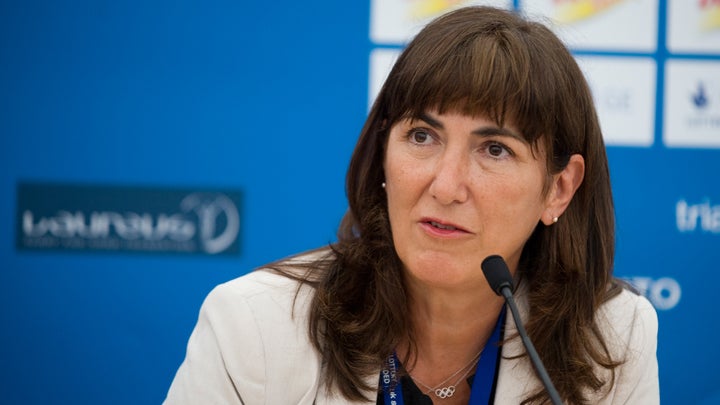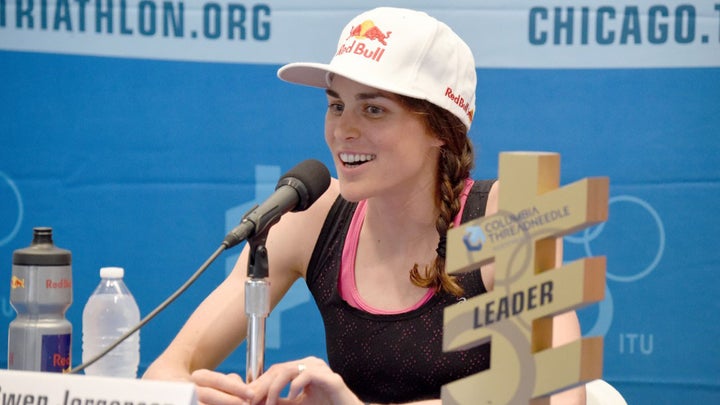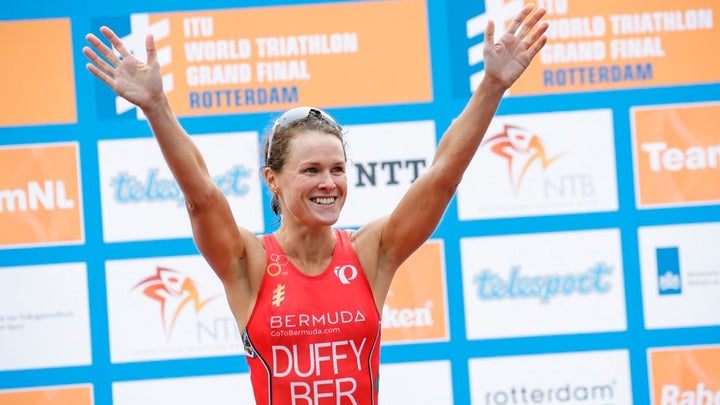Products You May Like
Get access to everything we publish when you
sign up for Outside+.
Celebrating Women’s History in Sport
As we celebrate Women’s History Month at Women’s Running, we are featuring women from all sports from our sister sites at Outside. Check out our full collection dedicated to past and present history makers in women’s sport and join Outside+ to keep learning about amazing women who are owning their journeys in sport.
The History Makers in Triathlon
We’re taking a quick look back at the history of triathlon and the role women have played in shaping the sport. Here are just a few historic landmarks:
1974 – Triathlon invented by the San Diego Track Club with the Mission Bay Triathlon. Forty-six people, including at least a dozen women, participated. The club has a storied history of leading the way in gender equity: To get around regulations prohibiting women from running with men at the Mission Bay Marathon in the 1960s, the SDTC created a separate women’s race of equal distance on the same course (one of the racers, Roberta “Bobbi” Gibb, would go on to make headlines as the first female to finish the Boston Marathon).
1978 – Judy Collins and her husband, Commander John Collins, both participants in the 1974 Mission Bay Triathlon, launch the Hawaiian Iron Man Triathlon in Waikiki, which combined the Waikiki Roughwater Swim, Honolulu Marathon, and a local cycling club route.

1979 – Lyn Lemaire becomes the first woman to complete the Hawaii Ironman Triathlon, finishing in 12:55:38. As the only woman in the race, she also earns the title of the first female Ironman World Champion.
1982 – Audiences are captivated by the finish-line crawl of Julie Moss at the Ironman World Championship. After leading for much of the race, Moss collapsed from heat exhaustion just before the finish, losing to Kathleen McCartney. Photo and video footage of the event, to this day, remains the most iconic image of Ironman.

1983 – “Triathlon: A Triple Fitness Sport” is the first book published on triathlon. The author, Sally Edwards, is a pioneer of women’s endurance sport, founding and qualifying for the first Olympic Marathon Trials in 1983, becoming one of the original founders of Tri Fed (which becomes USA Triathlon), racing more than 250 endurance events (including winning Western States), and publishing more than 25 books on sport, including 1991’s “Triathlons for Women.”

1988 – South Africa’s Paula Newby-Fraser clocks a dominating 9:01:01 finish at the Ironman World Championships, beating the women’s course record by 35 minutes and placing 11th overall. Newby-Fraser would go on on to win the Ironman World Championship a total of eight times.

1989 – The International Triathlon Union (ITU) forms—now called World Triathlon—and the first official World Championship event is held in Avignon, France. Upon discovering the men’s prize purse was larger than the women’s New Zealand’s Erin Baker confidently–and successfully–mounts a campaign for equal pay. The standard remains in place to this day, making triathlon one of the few sports that offers the same prize money to men and women.
1990 – The first women’s-only triathlon series, Danskin Triathlon, launches in Long Beach, California to encourage women and girls to experience multisport in a fun, supportive, and non-intimidating environment. Its spokesperson: Sally Edwards, who famously becomes the “last place finisher” at every race to help assuage fears of new triathletes that they would be the last person to cross the line. In subsequent years, Danskin would expand to more than 130 races and 250,000 participants, as well as inspire similar women-only events like Irongirl and Trek Women’s Triathlon Series.

1991 – The ITU launches its first full season of the World Cup circuit (what is now known as World Triathlon Series, or WTS). Eleven races in nine different countries make up the series, each one offering equal prize purses to men and women. American Karen Smyers is the first ITU World Champion.
2000 – Triathlon makes its Olympic full medal debut at the Sydney Games. 48 athletes from 24 nations competed in the women’s race. Switzerland’s Brigitte McMahon took the gold medal with a time of 2:00:52. She later tests positive for EPO, in 2005, and eventually admits to using the banned drug.

2004 – Susan Williams, a 35-year-old mom from Long Beach, California, nabs the first Olympic medal for the United States in triathlon, earning bronze at the Athens Games.

2004 – After a heartbreaking initial attempt in 2003, American Sarah Reinertsen rallies to a 15:05:12 finish at the Ironman World Championship, becoming the first female above-the-knee amputee to complete the race.

2007 – The triathlon world is shocked when rookie Chrissie Wellington of Great Britain, in a pair of borrowed shorts and with a broken bike pedal held together with glue, wins the Ironman World Championship in 9:08:45. Her Cinderella story was no fluke, as Wellington would go on to become one of the most dominant athletes in the sport, with an undefeated record, an Iron-distance world record (8:18:13, set in 2011 at Challenge Roth), and multiple wins at the iconic Alpe d’Huez triathlon.

2008 – Marisol Casado, a former elite triathlete from Spain, is elected President of the ITU, making her the only woman to head an international summer sport federation and only one of two in the entire Olympic program. Casado remains in the role today, winning re-election four times on a platform of gender equality and governing body quotas to ensure women are represented in the sport.

2009 – Anu Vaidyanathan becomes the first Indian triathlete, male or female, to complete an Ironman triathlon. In that same year, she becomes the first Asian triathlete to finish an Ultraman.
2013 – At the PruHealth World Triathlon in London, Shirin Gerami becomes the first Iranian woman to compete at a triathlon, training and racing in full hijab, or loose-fitting clothing and headscarf required under Iranian law.
2012 – After growing frustrated with a lack of coverage for women in triathlon press, Australian age-group triathlete Stef Hanson launches Witsup, the first media outlet dedicated solely to coverage of women’s triathlon.

2012 – With a win in her age group at Ironman Canada, 82 year-old Sister Madonna Buder becomes the oldest woman to finish an Ironman race. Buder, also known as the “Iron Nun,” also holds the record for oldest competitor at the USA Triathlon National Championships, finishing third in the 85+ age group in 2019 at aged 89.

2014 – Triathlon is designated as an NCAA Emerging Sport for Women, a move aimed at helping schools provide more participation opportunities for female athletes. In order to become a varsity collegiate program, a total of 40 schools must establish women’s triathlon teams by the year 2024.

2015 – Team USA women nab their first podium sweep at an ITU event, with Gwen Jorgensen, Sarah True, and Katie Zaferes claiming the top three spots at the World Triathlon Series Gold Coast event. They repeated the feat one month later by taking the podium yet again at the WTS London race.

2016 – Gwensanity sweeps the world as Jorgensen tallies up a 12-race WTS winning streak in 2014 and finishes an undefeated 2015 season (including a World Championship crown) in the lead-up to the Summer Olympics in Rio de Janerio. Her dominance continues at the Games, where she wins the first-ever triathlon gold medal for the U.S.

2016 – U.S. paratriathletes strike gold in Rio when Grace Norman and Allysa Seely win their respective races at the Paralympic Games. Americans Hailey Danz and Melissa Stockwell also win medals, combining to sweep the podium in the PT2 sport class along with Seely.

2016 – Flora Duffy of Bermuda makes history as the first (and only) person, male or female, to win three triathlon world titles in the same year, earning the WTS, ITU Cross Triathlon, and XTERRA crowns.

2015 – An anonymous Twitter account operating under the name “50 Women to Kona” calls out Ironman for its unequal distribution of spots for pro men and women at the Ironman World Championships – only 35 women are allowed to start compared to 50 men. The tweets (which are later revealed to be sent by pro woman Alyssa Godesky) launch a large-scale movement for gender parity in triathlon using the hashtag #50womentokona. The heightened awareness of gender disparity in triathlon leads to a number of concerted efforts to grow women’s participation in the sport, including Ironman’s Women for Tri program and USA Triathlon’s initiatives to recruit and retain female triathletes.
2018 – The inaugural Outspoken Summit is held in Tempe, Arizona. The event—the first triathlon conference geared toward female athletes, coaches, and industry members of all ranks—attracts more than 100 participants and multisport trailblazers, all working toward a goal of supporting women in triathlon and growing multisport participation.
2022 – USA Triathlon announces they have hit the mark of 40 minimum collegiate varsity women’s triathlon teams, a key milestone to becoming an official NCAA sport by 2024.
2022 – Brit Kat Matthews creates history as the first woman to break the 8-hour barrier for an iron-distance triathlon, crossing the line of the carefully-designed Sub7/Sub8 Project in 7:31:54.
2022 – Laura Philipp posts the fastest time ever at an Ironman-branded race, finishing 8:18:22 at Ironman Hamburg. Her time is just seven seconds shy of Wellington’s iron-distance record at Challenge Roth.
What happens next?
